Bank of Canada tasks Perkins + Will with the challenge of creating a modern workplace inside a historic building.
For nearly a century, the Bank of Canada has been an architectural symbol in the heart of Canada’s capital, holding a prominent place in the city’s history and urban fabric. Bank of Canada leadership shared a vision for a refreshed, interactive workplace, and tasked Perkins+Will with designing a modern legacy for the institution that would transform operations inside the new headquarters.
Completed in 1938, the Bank of Canada’s late neoclassical granite building was reimagined by celebrated architect Arthur Erickson in the late 1970s through the addition of soaring glass towers anchored by an expansive 12-story atrium and open-plan workplace. While extremely progressive for its time, Erickson’s original design had evolved over time and major upgrades were required to meet 21st century performance standards.
The resulting renovations transformed how the workplace operates and interfaces with the public realm, equipping the Bank with a modernized headquarters that will foster a culture of collaboration and exceed operational needs for decades to come.
When was the project completed?
2016
How much space?
835,000 GSF
Was this new or renovated space?
Renovation
SF per person?
479 SF per person
How many employees?
Approximately 1,700
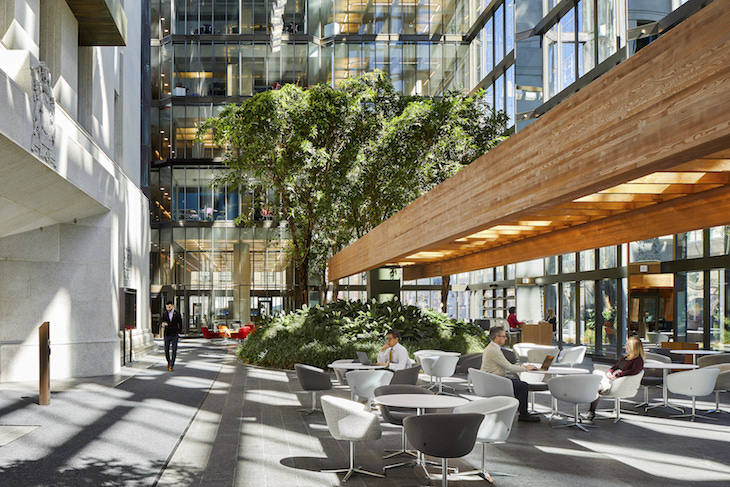
What is average daily population?
Approximately 1,600
Is there a mobile work or work-from-home policy? If so, what percent of employees are remote workers?
Yes. To accommodate the diverse needs of employees, the Bank of Canada offers a variety of flexible work arrangements, which include the option of teleworking. The bank also has staff who work at their regional offices.
Describe workspace types.
Open plan
What kind of meeting spaces are provided?
Flexible, technology-enabled spaces including non-typical environments such as lounge spaces and meeting tables.
What other kind of support space or amenity spaces are provided?
The new office features an IdeaSpace: an innovation lab with a unique look and feel that inspires creativity. A 12-story atrium includes a café and media resource centre. The adjoining Bank of Canada Museum features an inviting entrance within an outdoor presentation space. Food and beverage services on the ground floor of the building and integrated eating areas throughout the building make lunch breaks more efficient.
Has the project achieved any special certifications?
Pursuing LEED® Certification
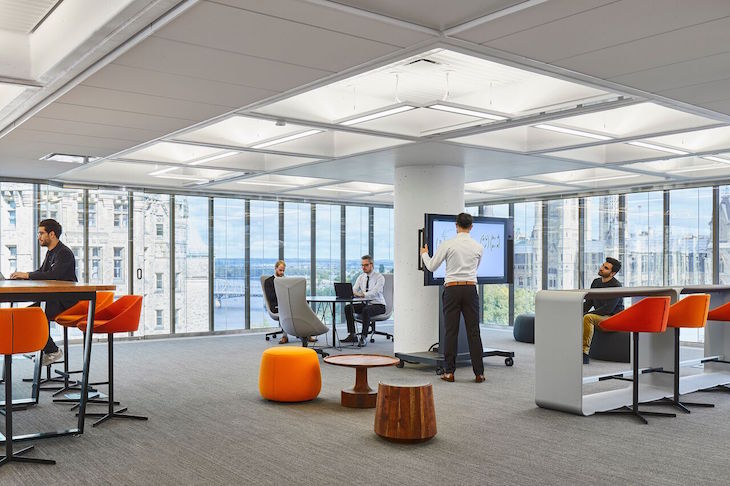
What is the project’s location and proximity to public transportation and/or other amenities?
The project is located in the heart of Ottawa, steps from the federal legislature. The office is directly served by 8 bus lines and the Confederation LRT line, which is scheduled to be completed in 2019. It is surrounded by the Sparks Street pedestrian mall, the National Arts Centre, and some of the best restaurants in the city.
Was the C-suite involved in the project planning and design process? If so, how?
In the planning stage of the project, the Board of Directors asked the bank to look at all options for how to proceed with upgrading the facility. Relocating permanently was one option. Staying in the facility and undertaking the renovations in a phased approach over multiple years was a second. The third option was relocating temporarily and completing the renovations over a shorter period of time. The bank chose the third option.
Numerous information-gathering sessions were held with bank leadership to analyze how employees were utilizing existing spaces. In response, the design team confidently moved away from private workspaces to an open environment. All interior modifications consciously drive a future-thinking workplace. Flexible, non-typical spaces create movement and cost efficiencies in building operations.
What kind of programming or visioning activities were used?
Early in the process, Perkins+Will partnered with the Bank of Canada to perform an extensive heritage audit and consultation with the community to identify which architectural elements could and should be preserved. Erickson’s original vision involved a seamless integration of architecture and landscape, which was the primary inspiration for the new design.
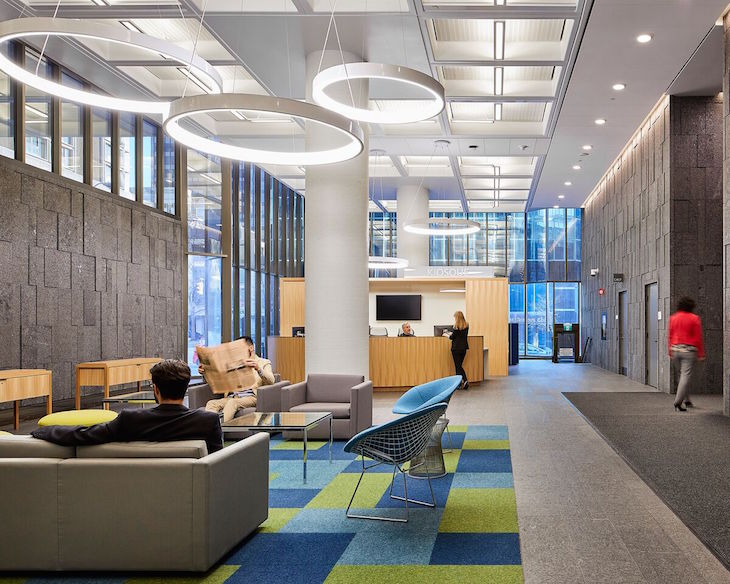
Were any pre-planning surveys conducted to get employee input?
Yes, surveys were sent to the Bank employees to gather information for programming and planning purposes. An amenity survey was sent out to gather statistics on the use of the current facilities, what amenities could be better implemented, and what new amenities should be considered.
Were there any other kind of employee engagement activities?
Bank staff were consulted at each stage of the design process, and every department contributed to the design of their own floors, choosing customized configurations to suit their work styles. Staff also had a say in the furniture design, which led to the introduction of ergonomic chairs and stand-up desks.
Were any change management initiatives employed?
Yes, change management was implemented by a consultant retained by the bank.
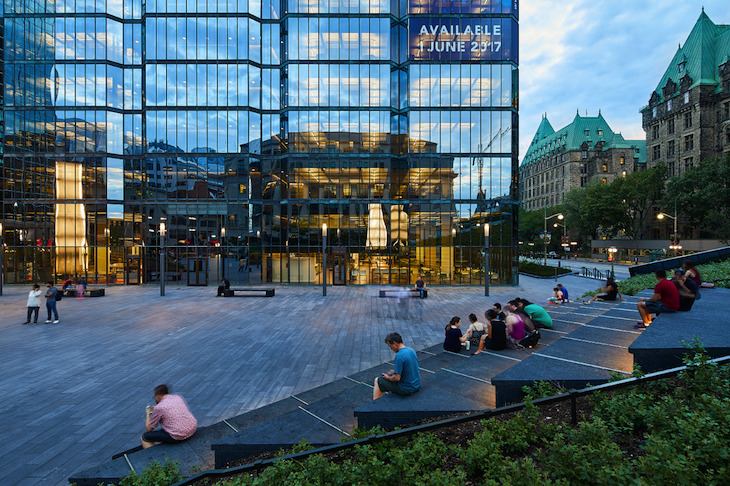
Please describe any program requirements that were unique or required any special research or design requirements.
The Bank of Canada wanted to undertake a new dialogue with the visitors and residents of the city by investing in public spaces around its head office. Now accessible to the public at grade, the newly reimagined Bank of Canada Museum provides direct education through interactive exhibits, programming, and the National Currency Collection. Admission is free. The East plaza was also redesigned as a vibrant space for local residents, visitors and Bank employees to gather and enjoy the outdoors.
Was there any emphasis or requirements on programming for health and wellbeing initiatives for employees?
Yes. A comprehensive analysis by both bank staff and external experts determined that the facility needed to be upgraded to align with modern requirements for health and safety standards and seismic stability, and to better meet the bank’s evolving security and business requirements.
The last major update to the bank’s head office occurred in the 1970s with Erickson’s addition of the atrium and glass towers. The requirements for a safe and efficient work place have evolved considerably since that time, as have the security and technological requirements for a G7 central bank.
Renewing the head office was also an opportunity to make it more energy efficient and environmentally sustainable. The buildings’ systems—ventilation, heating, plumbing and electrical—had reached the end of their lifespan. The buildings were also upgraded to address seismic, security, and health and safety issues. For example, the buildings needed to be equipped with sprinkler systems and more exits in case of emergency.
The renewal also presented an opportunity to add new health and wellbeing initiatives. The BeneFIT Centre (gym) and the Wellness Centre, along with Kitchen and Food Servery, Café grab-n-go, Knowledge Centre and News Hub and the innovation lab (IdeaSpace) are all programming requirements to benefit the employees.
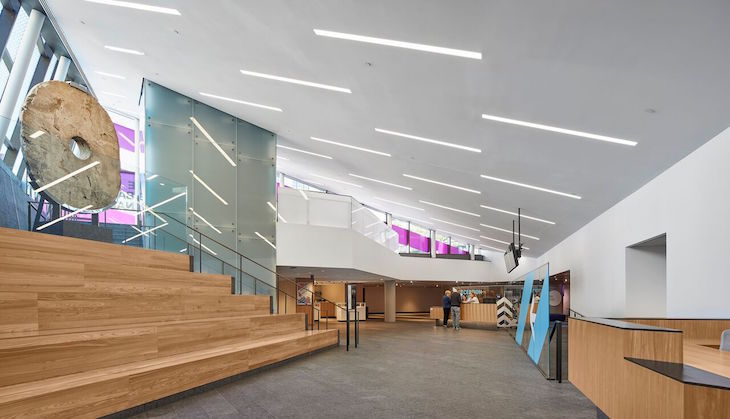
Were there any special or unusual construction materials or techniques employed in the project?
Dark bronze metal, angled glass and green-black granite sourced from Quebec were used to complement the building’s existing design. The interiors incorporate regional materials and manufacturers from the granite stone to the demountable walls and furniture from Canadian Companies. 1,000 existing Marcel Breuer Cesca Chairs were refurbished, reupholstered in vibrant jewel tones and reused throughout the bank. Existing Arthur Erickson desks were reused in a private phone room on every tower floor.
What products or service solutions are making the biggest impact in your space?
The most significant impact stems from the integration of modular work spaces and meeting spaces which are able to support every working function, from quiet isolation to meetings and working groups. Interior spaces now encourage face-to-face connection to enable knowledge exchange and support teamwork, which is essential in the rapid pace of today’s connected business world. The selection of flexible furniture resulted in collaborative spaces that can transform as the Bank’s business needs evolve.
What kind of branding elements were incorporated into the design?
The color palette for the interior design was inspired by the colors of bank notes. During the design process, the Bank of Canada introduced all their new colorful currency. The design team was inspired by the colors and created a warm and cool palette from the bank notes. These colors were implemented in the finishes and furniture from the east to the west towers. Shades of red and orange to greens and blues dot the interior landscape providing energy and vibrancy throughout the space.
What is the most unique feature of the new space?
The redesigned public plaza features dramatic crystalline triangles which rise from below grade, juxtaposing the architecture and skyline. The plaza includes generous outdoor seating, greenery, and a presentation space. Sculpted pavilions inspired by Canadian glaciers frame the public realm.
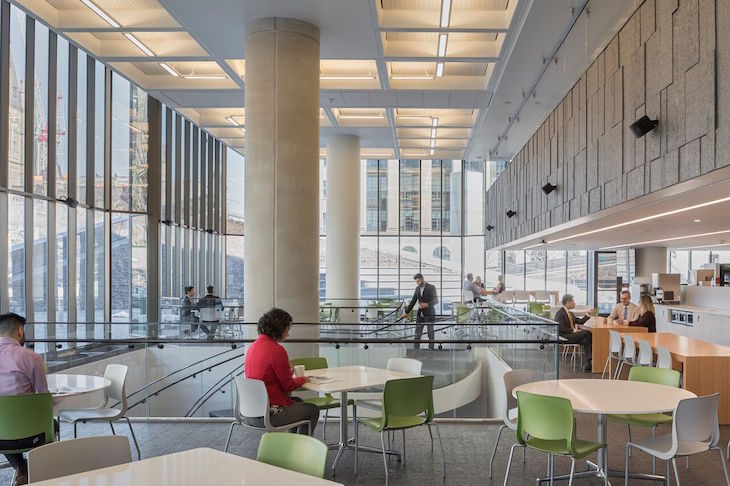
Are there any furnishings or spaces specifically included to promote wellness/wellbeing?
All workspaces are built with ergonomics in mind, including standing desks and supportive, adjustable chairs. Flexible spaces also allow and encourage employees to create an environment that supports individual working styles, both collaborative and social, and more quiet and secluded. The Bank has also deployed lighter laptops which, combined with seamless Wi-Fi throughout the building, allow staff to extend their “office” beyond individual desks.
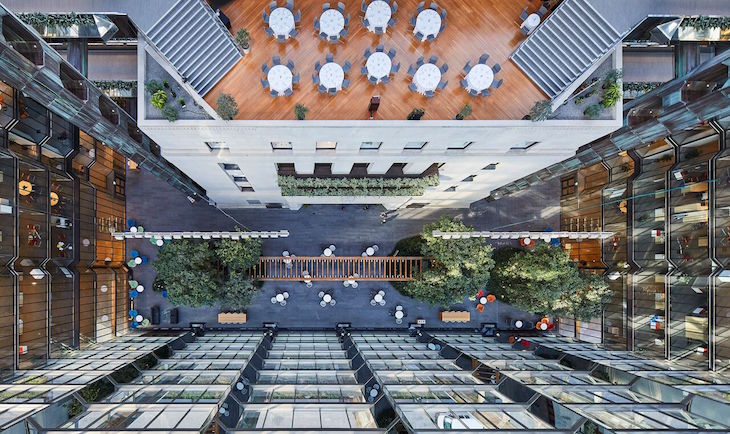
What kind of technology products were used?
All meeting rooms are equipped with AV and technology integration. A full-service conference centre is included as well as a Broadcast Auditorium. Wireless connectivity throughout the bank provides freedom to move and access alternative work zones anywhere in the buildings. Digital Room Reservation systems were included within the Conference Centre and Centre Building Meeting Rooms.
How did the company communicate about the changes and moves?
All moves and move planning were organized and communicated in collaboration with representatives from the bank’s departments. Changes and information about the renovated offices and temporary accommodations were delivered on the Bank’s internal website. Communications were broadcast by various bank officers, including the governor.
Prior to the End State move, tours were conducted throughout the bank. The bank and the design team conducted onsite tours to the departmental representatives of every space and amenity within the building. Tours were then provided for all bank staff, led by their departmental representatives.
Additionally, the bank and design team, along with a consultant, produced an animated video and flythrough of the entire building prior to completion of the project as a welcome video message in French and English that was distributed to all bank employees.

Were there post occupancy surveys? If so, what were the most surprising or illuminating or hoped-for results?
Yes, post-occupancy surveys were conducted following the move to a relocation space in order to gain insight and feedback that continued to guide the design team. Hopes and Fears for the End State design were documented. The Bank hoped for “Intelligent” Flexible Space, to preserve the facility, and unify the bank. The bank initially worried that a reduction in private offices might impact recruitment and retention.
Since moving back, the staff response to the new space has been overwhelmingly positive.
Tell us more!
Architecture and Interior Design: Perkins+Will
MEP Engineer: Bouthillette Parizeau
Construction Management: PCL Construction
Landscape Architect: DTAH
Heritage Consultant: EVOQ Architecture
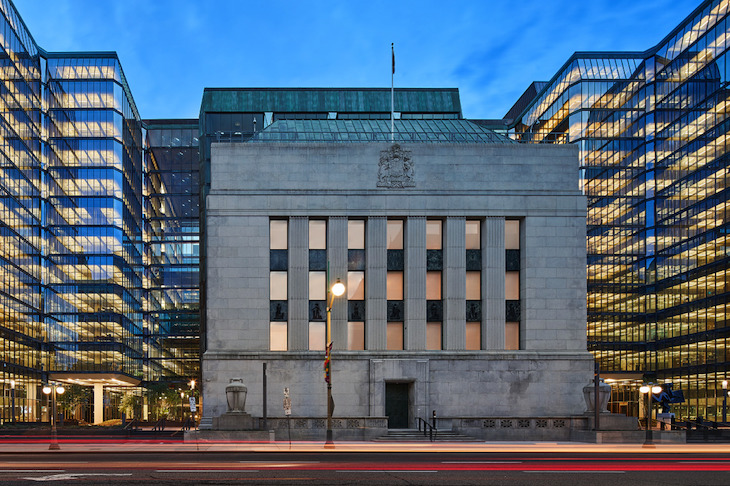



Nice post! Great job! Thanks for sharing!